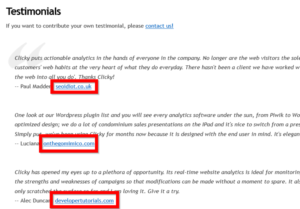
Why Quality Backlinks Should Be the Center of Your SEO Strategy
If you’re familiar with search engine optimization (SEO), or even if you’re just getting started with it, you’ve probably heard of backlinks. Simply put, backlinks (or inbound links) are any links that direct to a page on your website from another website. Since search engines use backlinks to determine your website’s popularity, authority, and relevancy, they’re one of the most important aspects of SEO. In fact, they’re arguably the most important. The more backlinks your website has pointing toward it, the better your site will be viewed in the eyes of a search engine.
However, if you want your keywords to truly rank effectively, you need to have not only just a sizeable number of backlinks but also a sizeable amount of quality backlinks.
What makes a quality backlink?
According to SEOMark, there are quite a few factors for a backlink to be considered quality. It must come from a trusted and relevant source, consistently send traffic to your page, have exact/phrase/synonym anchor text, is not easily acquired, and should be found within a block of content/text. Additionally, it should be on a page with PageRank, be next to other quality backlinks, and from a different source than your current backlinks. The equity created by the combination of all these factors is what the SEO community refers to as link juice.
Unfortunately, people have found numerous ways to deceive search engines resulting in tougher criteria for establishing quality backlinks. Disapproved practices such as hidden text or links, buying links, or link farms/link wheels can lead to your website’s ranking getting severely penalized and in extreme cases, banned from search results altogether.
Getting started building backlinks
When it comes to backlink building, there’s no shortage of ways to get started. One of the most tried and true methods is guest posting, which simply means creating and publishing an article or post on another person’s blog or website. Guest posting is a great way to build relationships and meet new people. Assuming the host includes a link to your website somewhere in your post, it’s also a great way to build quality backlinks.
Another easy method to build backlinks is by giving testimonials. It’s rare that a company wouldn’t want to display a positive customer testimonial, so try reaching out where you see fit. To add some credibility to your testimonial, companies will usually attach a link to your site along with it, which in turn gives you a quality backlink.
Here’s an example from backlinko.com:
A third method for quality backlink creation is through what’s known as broken link building. This method involves finding mentions of your brand across the web that don’t properly link to your website. Once you’ve found instances of these unlinked mentions, simply email that site’s webmaster and ask them to add your link. They’re usually happy to oblige (they mentioned you in the first place, right?). If this sounds like too much of a manually daunting process, you can use tools like BuzzSumo that will automatically find mentions of your brand wherever they occur.
These are just a few easy ways to get started with link building. For a more comprehensive list, check out 17 Untapped Backlink Resources from Backlinko.
I’ve built some backlinks, now what?
Like with every other SEO tactic, backlink building won’t provide results overnight. It’s an ongoing process that needs continuous attention and outreach for it to be successful. For efforts to pay off, it’s important to closely keep track of what sites are linking to you (and if they’re quality sites). You can do this with free tools like RankSignals or OpenLinkProfiler. Additionally, you should be ensuring that the anchor texts of these backlinks are relevant to your site. A generic anchor text of click this link won’t do your SEO much good, whereas something like visit our resource page to learn more about backlinking will provide your links with much more juice.
Here are some examples of generic anchor texts from SEM Rush:
Of course, if you find that a lot of your links’ anchor texts aren’t what you’d like, you can always reach out to the respective webmaster and ask them to change it. For more information on the different kinds of anchor texts and how they affect SEO, read this article from Ahrefs.
Quality backlinks are an extremely important part of search engine optimization and naturally should be a top priority if you want to see real results. With persistence and a dedicated effort, you can build a steady network of links and increase your website’s SEO equity significantly and meaningfully.
Have questions about backlinks, search engine optimization, or just digital marketing in general? Leave a reply in the comments below or email me at mulanski@wtwhmedia.com.






Hi. Thanks. It was informative.
Small question: Have you tried SERPstat for backlinks?
It has the same functions as your tools, seems good, but I still want to hear someone’s opinion )
Hey Mark,
I have not tried SERPstat, but it looks like it has all of the core functions of your standard SEO tool. It might be worth a demo to see if it has any major differentiators from tools like SEMRush.
If you end up trying it, be sure to let me know how it is!
A bit outdated the info , aint?
How do you figure?
Alexander must not understand that with SEO the strategies that have stood the test of time are generally the safest and best quality methods. SEO is about keeping things simple and basic, not about new cutting edge black hat strategies that might get you ranked for all of 1 week.
For Google, links which are not easy to get are ones with the highest quality. A link from Huffingtonpost, for example and other editorial links are mostly loved by Google today… The problem is, they are so hard to get.